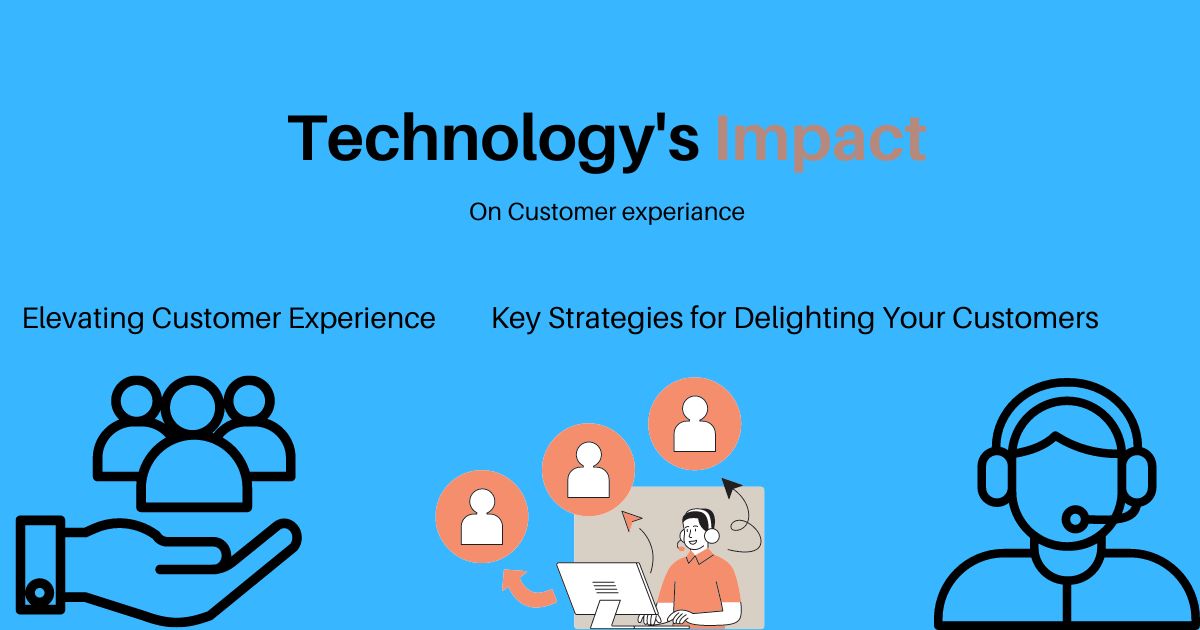Elevating Customer Experience: How Technology is Transforming Customer Service
Technology has become an important part of our daily routine of life and revolutionizing various industries. One sector that has experienced significant change is customer service. With the use of technology, businesses are now able to provide better service and enhance customer service. In this article, we will explore how technology is transforming customer service and discuss how companies can use these advancements to exceed their competition.

Elevating Customer Experience
In a world where products and services are increasingly commoditized, businesses are discovering that the key differentiator lies in providing an exceptional customer experience. Elevating customer experience goes beyond merely satisfying customers; it aims to create loyal brand advocates who keep coming back and actively promote your business to others. A positive customer experience not only boosts customer retention and loyalty but also drives word-of-mouth marketing and referrals, contributing to sustainable business growth. Let’s explore some key strategies for delighting your customers and elevating their experience.
Understanding Customer Needs and Expectations
The first step in customer experience is understanding your customer. This process starts is conducting market research and collecting customer feedback then analyzing the data you gain according to your needs; pain points the main points and expectations. Understanding your target audience allows you to tailor your products and services and support you to meet your requirements.
Personalization and Customization
Customers like personalized interactions that make them valued as individuals. Leverage customer data to personalize communications, offers, and recommendations. Use past purchase history, browsing behavior, and preferences to provide tailored product suggestions or exclusive promotions. Implementing customization options allows customers to configure products or services to their liking, enhancing satisfaction.
Seamless Omnichannel Experience
In today’s digital landscape, customers expect a seamless experience across all touchpoints. Whether they interact with your business through your website, mobile app, social media, phone, or in-person, ensure consistency and coherence in branding, messaging, and service quality. An omnichannel approach enables customers to switch between channels without losing context, enhancing convenience and satisfaction.
Empowered and Knowledgeable Customer Support
Customer support teams play a crucial role in shaping the overall customer experience. Empower your support agents with the right training, resources, and authority to address customer queries and issues effectively. A knowledgeable and responsive support team can turn potential frustrations into positive experiences, leaving customers impressed and satisfied.
Proactive Customer Engagement
Anticipate customer needs and reach out proactively to offer assistance or relevant information. This could include personalized recommendations based on past purchases, status updates on orders, or reminders about upcoming events or renewals. Proactive engagement showcases a genuine commitment to customer satisfaction and builds trust and loyalty.
Implementing Self-Service Solutions
Empower customers to find answers and solve problems independently with self-service options. Offer comprehensive FAQs, knowledge bases, tutorials, and community forums. Self-service not only reduces the burden on support teams but also empowers customers, providing them with immediate resolutions at their convenience.
The Rise of Artificial Intelligence (AI)
Artificial Intelligence has been a game changer in the field of customer service domain. AI-powered chatbots and virtual assistants are becoming the needs of many businesses and solving customer queries rapidly. These intelligent systems utilize natural language processing and machine learning algorithms to understand customer requests and provide accurate responses. By automating repetitive tasks and providing instant assistance, AI-powered solutions significantly reduce customer wait times and enhance satisfaction levels.
The Role of Automation in Streamlining Processes
Automation has revolutionized various aspects of customer service, enabling companies to streamline processes and deliver faster resolutions. Automated ticketing systems, for example, prioritize and categorize incoming support requests, ensuring that urgent issues receive immediate attention. Additionally, workflow automation tools can automate repetitive tasks such as order tracking, appointment scheduling, and refund processing. By reducing manual intervention, automation not only enhances efficiency but also minimizes the risk of errors.
Speed and Efficiency
Customers value their time and in return expect quick and efficient service. Minimize wait times, response times, and resolution times across all customer touchpoints. Utilize automation and AI technologies to streamline processes and provide instant responses to routine inquiries. A fast and hassle-free experience leaves a lasting positive impression on customers.
Emotional Connection and Empathy
Building an emotional connection with customers is a powerful way to elevate the customer experience. Show genuine empathy and understanding when addressing customer concerns or complaints. Acknowledge their feelings and demonstrate a commitment to resolving issues promptly. Emotional connections create loyal customers who feel valued and appreciated.
Continuously Seek Feedback and Act on It
Customer needs and expectations evolve. Continuously seek feedback through surveys, reviews, and direct communication. Act on the feedback received, making necessary improvements to enhance the customer experience continually. Transparency in acknowledging and addressing feedback helps in building trust and credibility.
Consistency and Reliability
Consistency is the foundation of a great customer experience. Deliver on your promises consistently and reliably. Whether it’s meeting delivery timelines, maintaining product quality, or providing after-sales support, be consistent in your actions. Reliability builds trust, which is essential for long-term customer relationships.
Key Strategies for Delighting Your Customers
Technology has become an important part of our life and customer service is no exception. Over the past decades, technological achievements have revolutionized the way businesses interact with their customers and changed customer services in remarkable ways. From streamlining communication to providing personalized experiences, technology has enhanced efficiency and customer e. Let’s explore how technology is transforming customer service:
Omnichannel Communication
Technology has enabled businesses to connect with customers across multiple channels seamlessly. Through phone calls, emails, chat, social media, and mobile apps, customers can interact with companies using these communication methods. This omnichannel approach ensures consistency and convenience, allowing customers to use these channels without losing context and increasing customer experience.
AI-Powered Chatbots
Artificial Intelligence and Natural Language Processing have given rise to intelligent chatbots. These virtual assistants can handle routine customer inquiries, provide instant responses, and even perform basic transactions. AI-powered chatbots operate 24/7, reducing wait times and enhancing customer service availability.
Personalization and Customer Insights
Data analysis and machine learning businesses can now gather and analyze more amounts of customer data, this wealth of information enables businesses to understand individual preferences, purchase history, and behavior patterns. Armed with these insights, businesses can offer personalized recommendations and targeted marketing campaigns, making customers feel valued and understood.
Self-Service Portals
Self-service options have become increasingly popular among customers. Technology allows businesses to create portals of feedback where customers can find answers to their asked questions, issues resolved, track orders, and update their information freely. This empowers the customer and also reduces the load on customer support teams.
Proactive Support
Technology enables businesses to monitor customer behavior and interactions in real time. By analyzing this data, companies can proactively reach out to customers who may be facing issues or have expressed dissatisfaction. This approach shows customers that the company cares about their experience and is committed to resolving problems promptly.
Social Media Engagement
Social media has become a powerful platform for customer service. Customers often turn to social media to seek assistance and voice their concerns. Through social listening tools, businesses can monitor and respond to customer feedback and inquiries, providing quick resolutions and building brand trust.
Mobile support
With the increasing usage of smartphones, businesses are using smartphones for their customer support, mobile apps and mobile-friendly websites provide easy access to customer support and product support anywhere anytime.
Video Support
Video chat and screen sharing have revolutionized customer support for technical products and services. Agents can troubleshoot issues in real time by seeing the customer’s problem firsthand, leading to faster and more accurate resolutions.
Automated Ticketing Systems
Technology has streamlined ticketing systems, allowing customers to submit their issues and track their progress easily. Automated ticketing systems route inquiries to the appropriate department and ensure no customer concern goes unnoticed.
Virtual Reality and Augmented Reality
In certain industries, such as real estate, tourism, and e-commerce, virtual reality (VR) and augmented reality (AR) are transforming customer service. Customers can virtually experience products, locations, or services before making a purchase decision.
Technology has revolutionized customer service by providing businesses with tools to offer more personalized, efficient, and convenient support. With the power of AI chatbots to social media engagements bring new changes and support timely and improve the customer support experience. As technology continues to advance businesses must adapt to the new tools stay upfront of customer service and meet the required changes to stay in the market demand and provide their customer better service. Technology continues to transform the customer service landscape, enabling businesses to provide exceptional support, boost customer satisfaction, and gain a competitive edge, companies have an array of tools at their disposal. By embracing these advancements and tailoring their strategies to meet evolving customer expectations, businesses can position themselves as leaders in their respective industries.
To read more about Technology changes Click Here
To read more visit here






